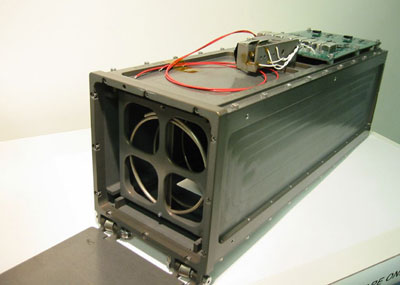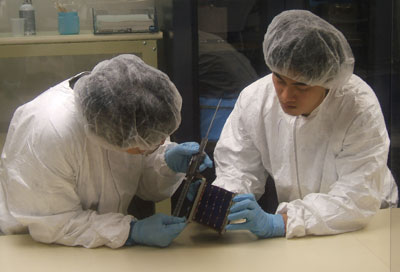The promise of innovation from university space systems: are we meeting it?by Michael Swartwout
|
| Are student-built spacecraft valuable because they provide technological innovation or because of the student training opportunities? |
If, instead, one were to canvass the exhibit booths of industry representatives, a different consensus would emerge. The value of student-built spacecraft is not in the hardware, but in the experience developed by students. Former NASA Administrator Mike Griffin expressed this view at the 2006 conference: “As students you need to learn science and engineering and those disciplines, and then you need to get out among companies or laboratories and continue to learn your trade.” In this view, student experiments are a luxury that must give way to other NASA priorities.
Who is correct? Are student-built spacecraft valuable because they provide technological innovation or because of the student training opportunities? We cannot hope to settle this matter in one article, but we will attempt to bring rational tools to the discussion. Specifically, we will draw upon an author-developed database of student-built spacecraft to attach numbers and specific examples to the debate.
We restrict this study to university-class satellites, by which we mean that untrained personnel (i.e. students) performed a significant fraction of key design decisions, integration and testing, and flight operations. The training of these people was as important as (if not more important) the nominal “mission” of the spacecraft itself. Exclusion from the “university-class” category does not imply a lack of educational value; it simply indicates that other factors—such as schedule or reliability—were more important than student education.
The first university-class spacecraft was launched in 1981; satellite number 119 was launched in September 2009. At present, an average of 12 university-class spacecraft are launched each year. While 59 schools worldwide have participated in at least one mission, there is a strong bifurcation: 21 schools have been responsible for almost two-thirds of all university-class missions, but the other 38 have flown only one mission, never to fly again.
That fact leads us to our second set of definitions: flagship universities and independents. A flagship university is designated by its government as a national center for spacecraft engineering research and development; in the United States, the US Air Force and Naval Academies are examples of flagships, and flagships have been identified in Japan, Germany, Italy, China, and many other nations. All other schools are grouped as independents. By definition, flagships enjoy financial sponsorship, access to facilities, and launch opportunities that the independent schools do not, and those distinctions are reflected in the numbers. Generally speaking, flagship schools build bigger satellites with more “useful” payloads, and they have sustained programs with multiple launches over many years. By contrast, the satellites built by independent schools are smaller, carry less sophisticated payloads, and are three times more likely to fail. Furthermore, 29 of the 38 “one-and-done” schools are independents; of the 37 independent schools to put on a mission, only eight ever flew two and only four of those eight are still active. An independent’s first-ever space mission is usually their last, i.e., the financial, administrative, and student resources scraped together to built the first satellite were not available for a second.
University-class innovators
Innovation, by definition, is something new and useful; for space missions, being “useful” is to significantly improve cost, timeliness, performance, or risk. In our research, we can point to two (and only two) university-initiated innovations. But those two are of such significance that they settle the question. It is only a slight exaggeration to say that universities started the first “small satellite revolution” of the 1980s, and what may be viewed as the “CubeSat revolution” of this decade.
The Surrey Model
Faculty and students in the Electrical Engineering Department at the University of Surrey developed the first two university-class spacecraft: UoSAT 1 (1981) and UoSAT 2 (1984). After those successes, they spun off a new company, Surrey Satellite Technology Limited (SSTL). SSTL pioneered the use of commercial off-the-shelf (COTS) technology in small satellites and created a business model around a modular spacecraft bus and professional training to jump-start fledgling national space programs. They have since expanded into more advanced systems, components, and sensors.
| We now speak of the “Surrey Model”, whereby a university develops an in-house spacecraft capability, advances to more-capable missions, and spins off the program into a profit-making entity. |
Arguments can be made about whether SSTL alone “invented” the COTS-based small satellite. It is inarguable, however, that SSTL was among the very first small satellite companies, and that its success helped create (and sustain) the commercial small satellite industry. Thus, by any measure, the University of Surrey made a significant contribution to the very idea of a small satellite, and created one of the first (and most successful) small satellite companies.
Furthermore, we now speak of the “Surrey Model”, whereby a university (a) develops an in-house spacecraft capability, (b) advances to more-capable missions, and (c) spins off the program into a profit-making entity. This approach has been adopted by several other programs, including: the University of Toronto Space Flight Laboratory, the Satellite Technology Research Center in Korea, the Technical University of Berlin, and the King Abdul Aziz City for Science and Technology in Saudi Arabia. All are actively building highly capable space systems for national governments, and several have international customers.
 A closeup of the P-POD CubeSat ejector. (credit: www.cubesat.org) |
CubeSat
If SSTL’s use of COTS technology and a standardized bus helped start the first small satellite revolution, then the CubeSat standard may be creating the second. To briefly summarize: in 2000, Profs. Bob Twiggs (then at Stanford) and Jordi Puig-Suari (California Polytechnic State University - San Luis Obispo) defined a new set of standards for very small student-built spacecraft; the intent was that students could build and fly a spacecraft within their academic lifetimes. Standard sizes and performance specifications were also intended to encourage collaboration between schools. The first CubeSats were launched in 2003, and six years later (a blink of the eye in aerospace time), more than forty have flown.
(Aside: while “CubeSat” is the catchall phrase, the real value of the CubeSat standard is the Poly Picosat Orbital Deployer (P-POD) launch carrier/ejection system. This small box carries three 10x10x10cm CubeSats and can be strapped on as ballast on practically any rocket. With the mechanical/electrical isolation provided by the P-POD, CubeSats are effectively decoupled from the launch vehicle. This decoupling allows very late selection of CubeSats for flight as well as the potential to hot-swap CubeSats among launchers. There are P-POD equivalents provided by Japan (T-POD), Canada (X-POD) and the U.S. Department of Defense (MEPSI).)
| Paradoxically, an unintended consequence of wide adoption of the CubeSat standard may be that university CubeSats are eclipsed by the professional programs! |
Still, the large number of CubeSat missions only “proves” that the standard is having the intended effect on university programs. The effect of this innovation is strongly demonstrated, however, in the number of CubeSats coming from outside the university. Here is an incomplete list of American government/industry programs with CubeSats flown since 2006: NASA Ames Research Center (GeneSat-1, PRESat, PharmaSat-1), NASA Marshall Space Flight Center (NanoSail-D), The Aerospace Corporation (AeroCubes 1-3), Boeing (CSTB-1), Hawk Institute for Space Sciences (HawkSat-1), and Tethers Unlimited (MAST). Besides those that have flown (and more in development from all these agencies), the Army, the National Reconnaissance Office and the National Science Foundation have near-term programs to develop CubeSat technology and missions: the NSF-sponsored RAX space weather CubeSat is scheduled to launch in early 2010; NRO is purchasing some 50 CubeSats in the next three years through its Colony program; and the Army has the eight-CubeSat SMDC-ONE mission readying for launch.
Paradoxically, an unintended consequence of wide adoption of the CubeSat standard may be that university CubeSats are eclipsed by the professional programs! It is instructive to note that all of the P-POD launches on US rockets (Minotaur 1, Minotaur 4, and the Falcon 1) have been government-sponsored CubeSats (NASA, DoD, or NSF), with the exception of one Cal Poly flight. In the next five years, universities may find it increasingly difficult to find available launch slots for their CubeSats.
Conclusion
The very first university-class space mission in 1981 (UoSat-1) led to the creation of SSTL, which helped lead the first small satellite revolution. The 28th rocket carrying university-class spacecraft released six CubeSats in 2003, which marks the second significant innovation. Still, it is easy to understand why university-class missions would be overlooked as sources of innovation: that first launch was nearly 30 years ago, and living “after” the COTS revolution, we may not recognize it as such. That 28th launch was recent enough that the full implications have not been worked out. Perhaps more significantly, those seven university-class spacecraft have been joined by 112 others, for a total of 119 spacecraft on 50 launches. Given the sheer volume of student-built spacecraft, and the comparative lack of significance of any one of those missions, it is easy to understand how university innovations can be overlooked.
Moreover, for every one university-class spacecraft that flies, we estimate that there are three more projects that haven’t flown. And so it is understandable if the conventional wisdom on university-class space missions is that they provide student training first, student training second, and perhaps useful space missions tenth. Certainly, well-trained students are the most important outcome of any university engineering program, and universities should not be ashamed of this fact. Still, even if it takes 119 spacecraft to produce two innovations of the magnitude of SSTL and CubeSats, we call that success.
| The CubeSat revolution has not played out—in fact, we hesitate to even use the phrase, as CubeSats are still in their infancy. |
Where will the next innovation come from, and what will it look like? We will not even attempt to answer; after all, who outside of Surrey anticipated that they could invent a business model around small spacecraft, and who outside of Stanford and Cal Poly saw the CubeSats coming? At most, based on our sample size of two, we will predict that whatever innovation comes will be a product of an independent school, not a flagship. While flagships enjoy a significant advantage over independent schools in every metric (number of spacecraft per school, quality of missions, odds of mission success), flagships have produced no identifiable innovations. Instead, the innovations we identified came from three independent schools, one of which had not yet flown a satellite! Why is that? We can only speculate, but our hypothesis is that the advantage of significant government funding brings the requirement to achieve success, which naturally leads to the use of standard industry practices. By definition, that is not a recipe for innovation. By contrast, the significant constraints placed on independent schools forces them to innovate, or not fly at all. (And, again, most of the independent schools don’t fly at all.)
As noted, the CubeSat revolution has not played out—in fact, we hesitate to even use the phrase, as CubeSats are still in their infancy. Still, it must be noted that with NASA, NSF, and NRO putting significant resources into CubeSat developments, and with two recent and one upcoming P-POD flights on US rockets, the future of CubeSats looks significantly different than it did even two years ago.
And thus we make no attempt to predict what will happen in the next two years, other to observe that 2010 is another potential watershed to match the events of 2000 (which gave rise to the CubeSat and set back the cause of university-class spacecraft in the US). On the manifest in 2010 are nine CubeSats with strong science/technology projects—arguably the first university-class CubeSats to be more than limited-functioning “BeepSats”. In addition to RAX, mentioned above, the other eight will ride on ESA’s first Vega flight; their results will be very indicative of the potential scientific benefits of university-class CubeSats, and CubeSats in general.
We wait with great anticipation.
